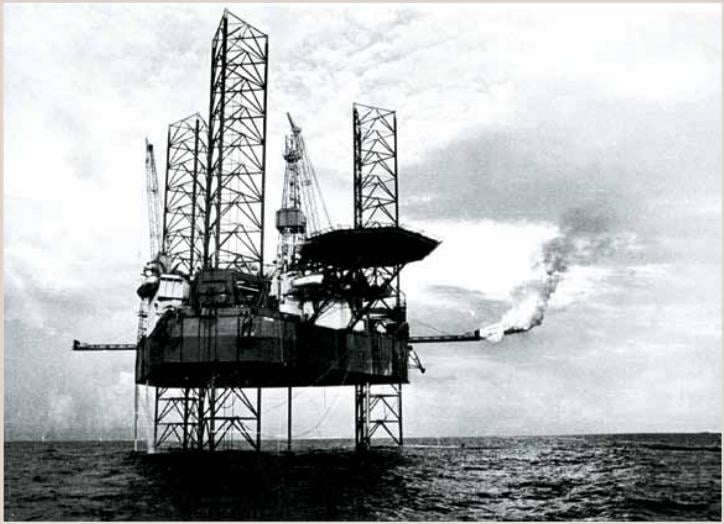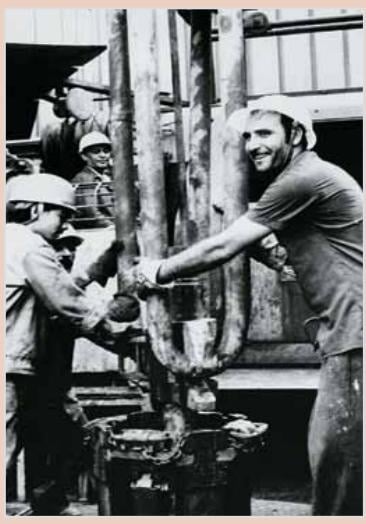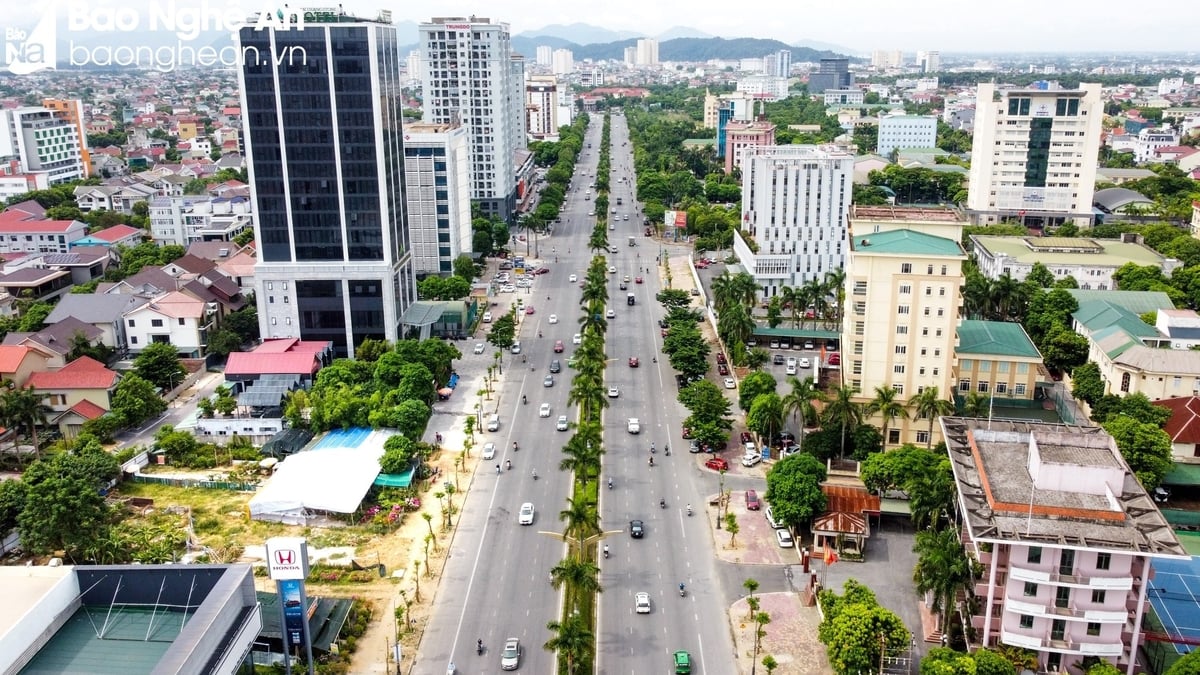Celebrating the 63rd Anniversary of Vietnam Oil and Gas Industry Traditional Day (November 27, 1961 - November 27, 2024)
From the first steps of the oil and gas generation in the 1960s "looking for fire" on the alluvial plains of the Red River Delta, to the "Orange Fire" (title of the memoir by writer Nguyen Duy Thinh) at Well GK-61 on the structure of Tien Hai C field, to the first fire that lit up the East Sea in 1984, there were countless sweats and efforts of the pioneering generations "looking for fire". In May 1984, the first oil was found on the continental shelf of Vietnam. On June 3, 1984, the oil celebration was solemnly held in Vung Tau. Oil and gas people were happy and proud, the people of the whole country were happy. The joy then spread to millions of Vietnamese hearts when Bach Ho field was officially put into operation on June 26, 1986 - the event that officially put Vietnam on the list of oil and gas producing countries on the world map.
Ekhabi jack-up rig discovers oil in Oligocene formation (February 24, 1986).
According to Mr. Le Quang Trung (former Party Secretary, Deputy General Director of Vietsovpetro Joint Venture), “In 1984, an oil well was discovered. The government immediately raised the issue of whether the Bach Ho field could be put into exploitation quickly. The principle of oil and gas production is that after discovering oil, reserves must be assessed. When the reserves are assessed to see whether they can be exploited or not, and how many years of exploitation will take, then drilling rigs can be put into exploitation. Technical staff from both sides assessed that there was oil before, and if they continued to drill, there would definitely be oil that could be exploited with a large output, so they conducted exploratory drilling while building offshore drilling rigs. This is a very risky job, because if the reserves do not meet the exploitation requirements, building rigs is a waste of money.”
The first oil was transferred to the Krum ship on June 26, 1986, amid the general joy of the country, of the Vietsovpetro staff and of oil prospectors in general. But for the leaders and officers of the Geology Department of the Vietsovpetro Joint Venture, that joy was not complete. The output was only a little over 100 tons/day, the wellhead pressure was low, around 20 at, indicating weak reservoir energy. The belief in a new page, a renewed and prosperous country, was as great as the anxiety of the Vietsovpetro Joint Venture and the Party and State leadership.
“When we started to exploit Bach Ho field, we found that the reservoir energy was very low. After only 4 months, the flow rate dropped from about 100 tons/day to about 20 tons/day. The wells drilled at position 1 about 3-4m away gave results that were not as expected. This caused pessimism not only in Vietnam but also in Russia... Given the not so great prospects of Vietsovpetro, the two sides argued fiercely: should we abandon or not abandon this Bach Ho field,” Mr. Ngo Thuong San (Honorary Chairman of the Vietnam Petroleum Association, former General Director of the Vietnam Oil and Gas Corporation) recalled.
Whether to abandon Bach Ho or not was a very big issue at that time. And of course, to this day, we still hear the name Bach Ho, all thanks to the bold but also decisive decisions of the Board of Directors at that time. The Vietsovpetro joint venture could have been completely wiped out if it were not for the firm belief of comrade Do Muoi in the future of Vietnam's oil. He was also a person who had strong faith in cooperation with the Soviet Union.
"Miracle" of the Oil and Gas Industry
In the historical context at that time, when the Soviet Union had “Perestroyka (reform)” and Vietnam had the “Doi Moi” policy, business had to be effective. Therefore, the question of whether or not to continue exploiting Bach Ho field... became acute for the Vietsovpetro Joint Venture. There was oil in the North dome but it had not been exploited, while in the South dome, the wells in MSP-1 were gradually going out, and the MSP-2 platform was submerged under the waves. Moving the MSP-2 platform base to the North became the key task. This should have been done during the good sea conditions in May, but because the Soviet side had not yet prepared a plan, it was postponed until September 1988.
While waiting for construction materials, Vietsovpetro implemented the proposal of the leader of the Offshore Drilling Department on June 24, 1988, retesting the basement layer of the BH-1 well, which was running out of oil from the Miocene. As a result, on September 5, 1988, the oil flow from the top of the basement erupted strongly with a flow rate of 407 tons/day and the BH-1 well was immediately put into operation (September 11, 1988).
|
Oil discovered in fractured basement at well BH-1 of Bach Ho field (Photo). |
The memoirs of Mr. Vovk V. S., in the years 1988-1993, General Director of Vietsovpetro, wrote: “When I returned, of course I asked about the work situation at the first well. The oil flow in this well was then nearly 7 tons / day and night and it was “gradually dying out”. I ordered the planning of the drilling and the delivery of the necessary equipment to drill and test the next well. We drilled a hole, conducted an inspection, and did not detect any problems. What to do? Continue drilling! The bell rang at 3 a.m.: “The well is operating, the pressure is about 120 atmospheres!”. The next morning, we quickly prepared and strapped the well and put it into operation in the same state as the drill pipe and drill bit. In one hour, the flow achieved was 1,200 tons of total oil. 4 months later, the new well was transferred from the temporary scheme to the regular one” .
The discovery and exploitation of oil and gas in the fractured granite basement immediately changed the strategy for the construction and development of the Bach Ho field. In October 1989, the average daily flow of 35 production wells was 4,598.7 tons, the average flow of 1 well was 255 tons/day, and that of a new well was 618 tons/day. Scientists have calculated that, without the wells exploiting the basement rock, the average daily output from 1 well would be only 94.2 tons, and that of a new well would be 121.5 tons. The NIPI Offshore Petroleum Research and Design Institute began to build a new development plan for this field. By December 1, 1991, the average daily output of Vietsovpetro reached 12 thousand tons.
According to Mr. Ngo Thuong San, not only has Vietnam succeeded in discovering oil in the basement, but it has also organized the exploitation of Bach Ho mine effectively with very high output. In just a short time, the peak output has reached nearly 12 million tons/year. That is a record output that no other oil and gas mine in the basement, especially in granite basement, has ever achieved. These initial successes have become very valuable documents contributing to petroleum science in the region and the world.
The name “Bach Ho” has entered the world’s oil and gas literature and become an achievement of great scientific and economic value, greatly changing the traditional oil and gas exploration object. These achievements have placed Vietnam on the world oil and gas map, marking a solid step forward, affirming a promising future for the Vietnamese oil and gas industry./.
Tr.L
Source: https://www.pvn.vn/chuyen-muc/tap-doan/tin/b605fce7-5e1e-4463-bbdd-c4f32dbd8901




































































































Comment (0)